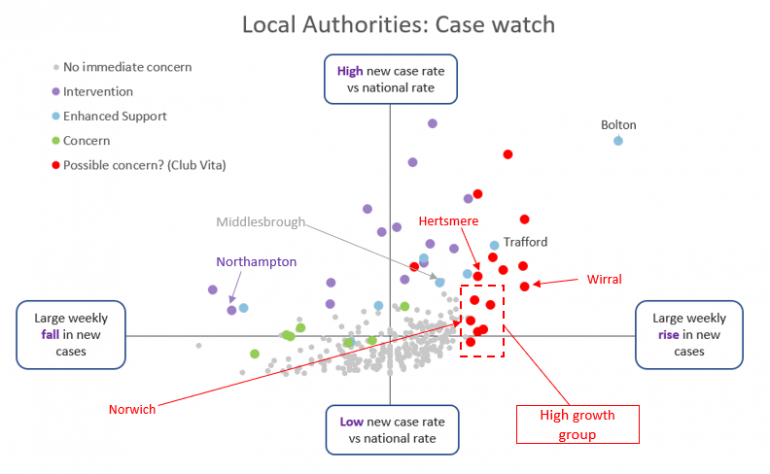Of the 15 authorities we highlighted, 8 appeared on this week’s watchlist, along with a further 5 other areas. In more positive news, 3 areas were taken off the watchlist. In this blog we explore these changes to the watchlist and look at the authorities we highlighted which didn’t appear on the latest watchlist but may be at risk of entering this Friday.
The latest watchlist
Public Health England publishes a weekly surveillance report exploring the national and local new COVID-19 cases data for England. One of the outputs of this surveillance is a “watch-list” of local authorities split into three categories:
- Intervention: These authorities have specific restrictions in place which are more limiting than those in place for England generally i.e. there is some form of local restriction (“lockdown”).
- Enhanced Support: The local authority is gaining additional support and resources from central government, including increasing mobile testing capacity.
- Concern: Highlighted as having high prevalence of COVID-19, the local authority is taking additional targeted actions in order to control COVID-19 case numbers. This can include additional testing in care homes and increased community engagement with high risk groups.
Last week we explored the then current watchlist, and considered whether there were local authorities at risk of joining the watchlist. We specifically highlighted a number of local authorities where either there had been high (and statistically significant) growth in the weekly new cases and/or the case rate was high compared to the national average. These were marked red in our “Case watch” scatterplot; reproduced below with some additional annotations:

The updated watch list saw 13 new additions, three changes to the status, and three local authorities drop off the list. 1 in 6 of the English population lives in the local authorities covered by the current watch-list.
- Bolton and Trafford moved from “Enhanced Support” back up to “Intervention”. From the chart it is clear why PHE reversed the planned easing of restrictions in those areas in the face of high, and rapidly rising, new cases.
- Northampton moved down the concern levels – from “Intervention” to “Enhanced Support”. This would seem consistent with it having the lowest case rate amongst those in the Intervention group, and a large week-on-week fall. The surveillance report also notes how the outbreak in that area is almost solely due to a workplace outbreak at a sandwich-making factory. This highlights how NHS Test and Trace and identifying the source of local outbreaks can be important in the ongoing battle to contain COVID-19.
- 13 new authorities were added to the list. Of these 8 were local authorities we highlighted as potentially of concern, and at risk of joining the watchlist (the red dots in the chart). Breckland, Great Yarmouth, Norwich and Rossendale joined the watchlist at the “Enhanced Support” level, whilst Corby, Kettering, Leeds, and South Tyneside joined at the “Concern” level.
- Middlesbrough joined the list at the “Concern” level. We can see1 it was on the boundary of the thresholds we had used for flagging local authorities and so it is not surprising that it was flagged up by PHE.
- The remaining four local authorities new to the list are all within Norfolk and (geographically) close to Norwich. Broadland, King’s Lynn and West Norfolk, North Norfolk and South Norfolk were all added at the “Enhanced Support” level, but PHE note that this is owing to a workplace outbreak at a poultry farm.
- Newark and Sherwood, Slough and Wakefield are no longer flagged as of concern.
Who else did we highlight?
Last week we highlighted 7 further local authorities which have not appeared on the latest PHE watchlist. For five of these (which appear in the “high growth group” marked on the chart) this could be because the outbreak is highly localised and contained, or it could simply be that the absolute numbers of daily new cases are not high enough yet to warrant greater interventions. Either way, we suspect North Somerset, Redcar and Cleveland, Stockton-on-Tees, Warrington and Wycombe to be areas of interest to PHE.
For Hertsmere and Wirral both the case numbers, and the week-on-week growth are high, and comparable to other areas where support/interventions are in place. Our analysis used slightly more recent data than that used in the watchlist, suggesting that these two areas may be at risk of entering the watchlist this Friday.
In Wirral
there already appears to local activity urging residents to help slow the
growth in new case numbers, whilst Hertfordshire County Council is attributing
the rise in Hertsmere to a number
of large social gatherings amongst young adults in private homes. Whether
this publicity will stem the rises in case numbers sufficiently to avoid the
need for further action remains to be seen.
Direction of travel
The direction of travel for new cases is concerning. More authorities have been added to the PHE concern list than were taken off. We have highlighted some additional authorities that concerned us last week and we will continue to monitor our “case watch” over forthcoming weeks.
One concern we will be looking closely at is the
“migration” of the points in our chart. Like a flock of migrating birds, there
seems to be some momentum behind local authorities moving to the right (growing
case numbers) and upwards (high daily new cases). We hope that the public
health interventions continue to contain COVID-19 and prevent a second wave
taking flight….
Notes:
1. You may struggle to see the grey dot for Middlesbrough as it is largely obscured by a blue “Enhanced Support” dot.





